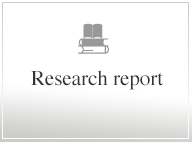Chlorella research report
- HOME
- Research report
- Chlorella research report
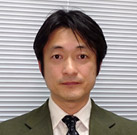
The Dinector of "Society for Chlorella and Functional Plants Research"
President of Research Institute of Mycology and Pharmacology
Takeshi Otsuki, Professor

Chlorella intake attenuates reduced salivary SIgA secretion in kendo training camp participants
(Otsuki T, Shimizu K, Iemitsu M, Kono I. Chlorella intake attenuates reduced salivary SIgA secretion in kendo training camp participants. Nutrition Journal, 2012)
Relationship between immune function and stress
Moderate exercise increases immune function, while higher intensities suppress it (Figure 1). Salivary secretory immunoglobulin A (SIgA) plays an important role in mucosal immunity in humans and acts as the first-line defense mechanism against pathogenic bacteria and viruses. Strenuous exercise suppresses salivary SIgA secretion and increases the risk of infection. For example, Yamauchi et al. [Reference 1] reported that during a rugby camp, participants’ salivary SIgA decreased by about 25% and the number of symptoms of upper respiratory tract infection (common cold syndrome) increased. Akimoto et al. [Reference 2] also reported that the salivary SIgA decreased by about 45% during a 3-day soccer competition involving 6 games.
Not only the general public, but especially athletes who continue hard training have an important issue not to lower the immune function in order to maintain their conditions.
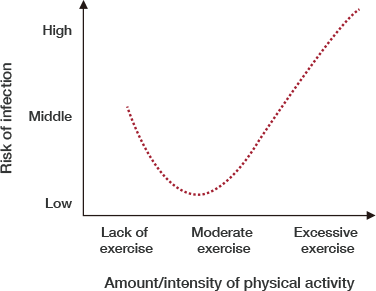
Figure 1. J curve for exercise and infection risk
(Reprinted and modified from Nieman DC: Exercise, upper respiratory tract infection, and the immune system. Medicine Science Sports Exercise 1994, Vol. 26, No. 2: 128-139)
In 2011, the International Society of Exercise and Immunology issued a statement that there is no supplement recommended for athletes concerning SIgA. However, our research group has demonstrated that chlorella intake promotes salivary SIgA secretion in healthy individuals, and this study examined the effect of chlorella in athletes.
Methods
Intervention studies were conducted in female subjects who belonged to a national-level university kendo team and participated in a spring training camp (for 6 days in March) and a summer training camp (for 4 days in August). Ten female subjects (aged 20 ± 1 years) who participated in the spring and summer training camps were randomly divided into 2 groups. One group took placebo tablets during the spring camp and chlorella tablets during the summer camp; 30 tablets per day (15 tablets twice daily, at breakfast and dinner) from 4 weeks before the camp to 4 or 5 days after the camp. The other group took chlorella tablets during the spring camp and placebo tablets during the summer camp. Saliva was collected before the camp, and on the second, middle, and final day of the camp. The SIgA level and saliva flow rate were measured, and the participants' subjective physical conditions were also assessed. The subjects recorded the following subjective ratings: "lightness of body," "fatigue," and "muscle tension." These ratings were subjectively assessed on a 5-point scale from 1 (light) to 5 (heavy) on the same day as the day of saliva collection.
This study was conducted with the approval of the ethics committee of the Graduate School of Comprehensive Human Sciences, University of Tsukuba.
Results and discussion
No significant change in body weight was observed in either the placebo group or the chlorella group during the study period. Regarding the self-assessment of physical condition, the score for "lightness of body" was significantly lower on the second, middle, and final day of the camp than before the camp in the placebo group, whereas, it was significantly lower only on the middle day of the camp in the chlorella group. The score for "fatigue" was significantly higher on the second, middle, and final day of the camp than before the camp in the placebo group, whereas, it was significantly higher only on the middle day of the camp in the chlorella group (Figure 2). In addition, the salivary SIgA secretion rate (μg/min), which was obtained from the salivary SIgA level (μg/mL) and the salivary flow rate (mL/min), was significantly lower on the second, middle, and final day of the camp than before the camp in the placebo group, whereas, no significant decrease was observed in the chlorella group during the camp (Figure 3).
These results demonstrate that chlorella intake can suppress the reduction in salivary SIgA during a sports training camp.
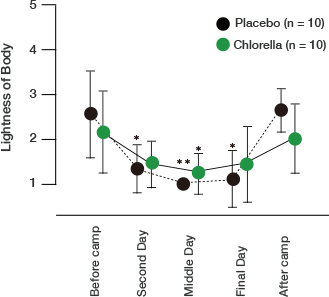
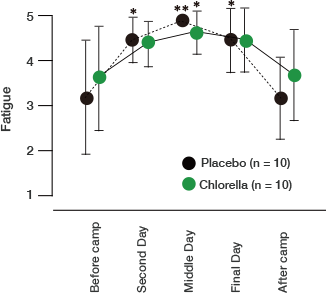
Figure 2. Self-assessment of physical condition during the kendo training camps
Values are expressed as mean ± standard deviation. *P < 0.05 vs before the training camp. **P < 0.01 vs before the training camp.
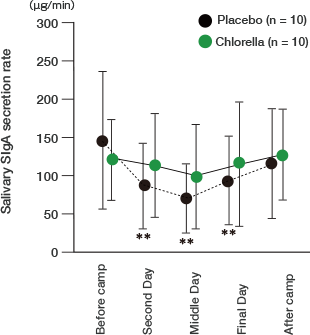
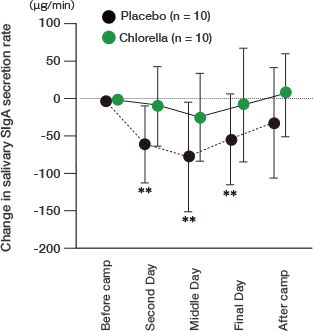
Figure 3. Salivary SIgA secretion rates and changes in salivary SIgA secretion rate during the kendo training camps
Values are expressed as mean ± standard deviation. **P < 0.01 vs before the training camp.
Reference 1. Yamauchi R, Shimizu K, Kimura F, et al. Virus activation and immune function during intense training in rugby football players. Int J Sports Med 2011, 32: 393-398.
Reference 2. Akimoto T, Nakahori C, Aizawa K, et al. Acupuncture and responses of immunologic and endocrine markers during competition. Med Sci Sports Exec 2003, 35: 1296-1302.

